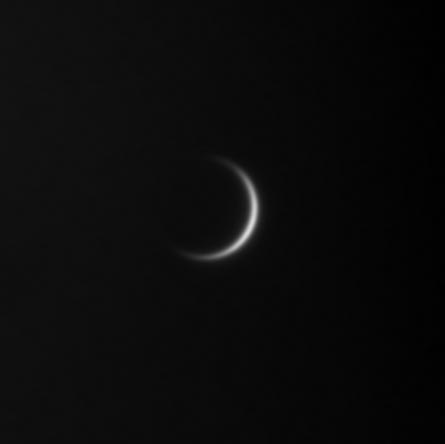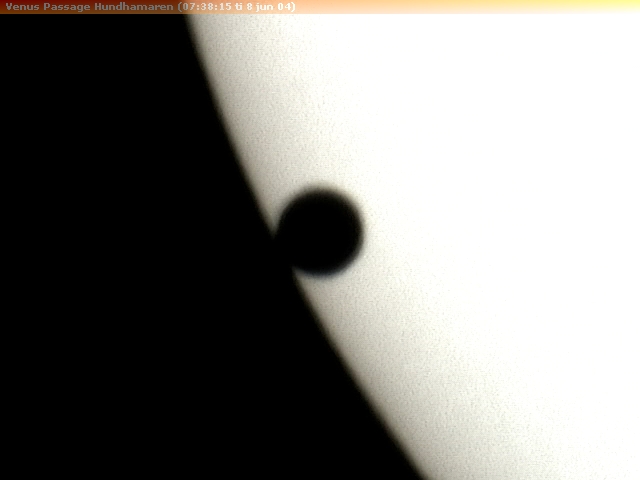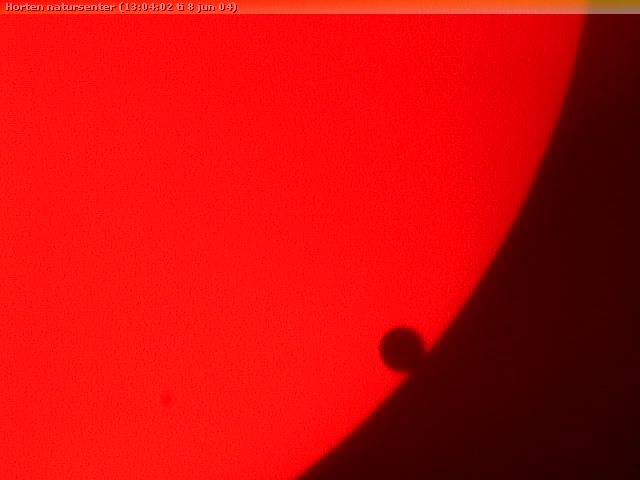The transit of Venus that took place on June 8, 2004 was the first time since 1882 that a planet with an atmosphere moved across the solar disk.
During the five transits of Venus that had been observed prior to 2004 many people reported the occurrence of strange phenomena. For the first time these phenomena could be documented photographically.
A RING OF LIGHT
During the transit we can only observe the black night side of Venus. But the planet is surrounded by a dense atmosphere. Some sunlight passes through these layers.
When Venus is very close to the solar disk, the outer layers of its atmosphere can be observed as a faint ring around the black disk of the planet. This atmospheric ring is described briefly in literature and drawings from previous transits, but it had never been imaged before June 8, 2004.
Studies of stellar light passing through the amospheres of planets during transits tell us a lot about the composition of the atmosphere and therefore about the conditions prevailing on the surface. When planets around distant stars transit their mother stars we have unique possibilites to find out if there is oxygen or water vapour in the atmospheres. The presence of such substances would strongly indicate that there is life on the planet!

During the transit: We see the atmosphere of Venus as a bright bow outside the solar disk. This image of exceptional quality comes from the 1 meter Swedish solar telescope on La Palma. Even on the solar disk the atmosphere of can be glimpsed.
Photo: Swedish Solar Telescope/Institute for Solar Physics

Photo of Venus taken June 6, 2004 – two days before the transit. As Venus moved closer to the Sun the planet was surrounded by a thin, bright brim gradually appearing around the planet. Here it is more than a half circle.
Photo: Odd Trondal

Venus imaged one day after the transit. The whole atmosphere can be seen as a glowing circle. This is a truly unique view!
Photo: Odd Trondal
THE BLACK DROP EFFECT
When Venus is close to the solar limb it seems to stick to the limb. In earlier times this phenomenon made hard to clock exact times for 2. And 4. Contact. It was very hard to tell when Venus had left the limb since the area between Venus and the limb becomes black.
The reason for this phenomenon and its extent has been discussed. For the first time the phenomenon has been documented photographically. The atmosphere of Venus, optical illusions due to the extreme difference in brightness between the Sun and Venus in addition to turbulent air are popular explanations.

The black-drop-effect at 3. contact. Venus has almost reached the limb on its way out of the disk. The black Venus disk is “sticking” to the limb before they actually touch. This is called the black-drop-effect.
Photo: Jarle Aasland

Venus has moved further and is now longer circular due to the black-drop-effect.
Photo: Trond Hugo Hermansen

The black-drop-effect when moves onto the solar disk.
Photo: Brynjar Berg

Black-drop-effect when Venus leaves the solr disk.
Photo: Tore Rolf Lund/Horten Natursenter
MORE INFORMATION
Major celestial events in Norway 2010-2015
| 
